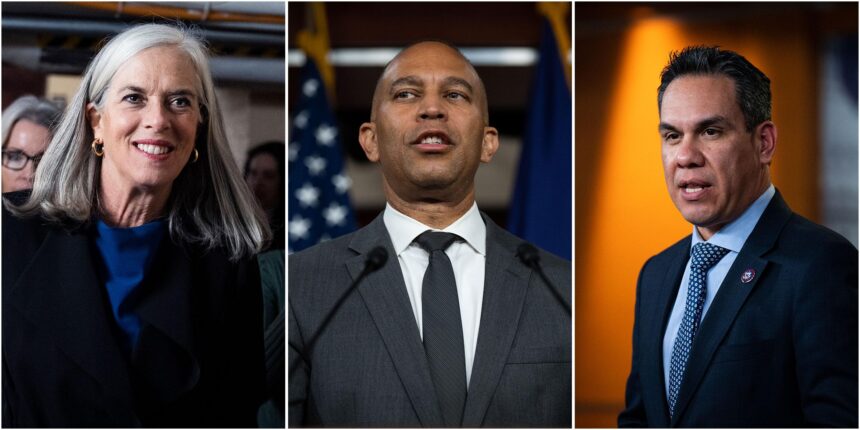Democratic leaders stood their ground Tuesday as an escalating dispute threatened to culminate in mass firings, framing the threat as a deliberately punitive political tactic.Party officials vowed to contest any move they said would strip jobs from public- and private-sector workers alike, arguing the measure was designed to intimidate opponents rather than solve policy problems.
“Cruelty is the point,” one senior Democratic official said, summing up the party’s assessment of the maneuver. The standoff – unfolding against a backdrop of intense partisan fighting over budget priorities and personnel authority – raises the prospect of widespread layoffs, legal battles and a bitter fight over the limits of political power in coming weeks.
Democratic leaders reject mass firing threat and announce legal challenges and emergency legislation plans
Democratic leaders, speaking from the Capitol and from state party headquarters, rejected the mass-firing ultimatum as legally baseless and politically motivated, saying it would inflict “unacceptable harm” on thousands of public- and private-sector employees. “Cruelty is the point,” one senior Democrat said, framing the move as a deliberate effort to terrorize voters ahead of crucial elections. They announced simultaneous legal and legislative responses and outlined an immediate, multipronged plan to prevent implementation: • File emergency lawsuits in federal courts • Seek temporary injunctions and stay orders • Draft emergency legislation to protect affected workers
Legal teams will mobilize within days and congressional leaders promise expedited floor action if agency or executive orders proceed. Strategists said the party will couple courtroom filings with rapid-fire messaging and union coordination to build public pressure. Key legal arguments expected to be advanced include • Violations of civil service and labor protections • Due process and equal protection claims • Exceeding statutory authority , and lawmakers vowed to use emergency appropriations and short-term bills as a “legal and legislative firewall” until longer-term solutions can be enacted.
Unions and community groups mobilize rapid response teams to protect workers and document abuses
Unions and neighborhood organizations swept into action within hours of the first warnings, setting up coordinated rapid-response teams at job sites, transit hubs and community centers. Teams of legal observers, medics and bilingual volunteers staged visible presences to deter predatory firings while documenting alleged abuses with timestamps, geo-tagged photographs and witnessed affidavits.Organizers said the strategy is both protective and prosecutorial: stabilize workers on the spot, secure medical or relocation help, and create airtight evidence packages that can be turned over to lawyers, regulators and reporters within 24-48 hours.
- 24/7 hotline staffed by trained intake workers
- Rapid-response legal teams for emergency injunctions
- On-site translation and trauma-informed medical care
- Encrypted documentation and chain-of-custody protocols
| Role | Primary task |
|---|---|
| Legal observer | Document & advise |
| Medic/trauma counselor | First aid & referrals |
| Outreach coordinator | Relocation & shelter |
Documentation is treated as evidence, not anecdote: volunteers follow standardized intake forms, preserve digital files in encrypted clouds and log every interaction to preserve a clear chain of custody for possible litigation. When employers test the boundaries of law and decency, rapid-response leads upload incident packets to legal teams and to a public dashboard used by reporters and elected officials, turning immediate crisis response into sustained political pressure that organizers say is essential precisely as, as several union leaders put it on the record, “cruelty is the point” of these mass intimidation tactics.
Messaging shifts to human stories and policy alternatives to frame cruelty as deliberate and sway undecided voters
Democratic strategists have pivoted from abstract policy debates to a more visceral communications campaign, centering the lived experiences of people facing job loss, eviction and family separation. By elevating first-person accounts – from a laid-off teacher to a parent forced to choose between rent and medicine – leaders aim to make the case that harm is not accidental but intentional; as one senior lawmaker put it, “cruelty is the point.” The messaging is designed to test whether vivid, relatable storytelling can break through partisan filters and move undecided voters who respond more to human consequences than to ideological framing.
Behind the anecdotes, campaign and caucus teams are pairing stories with concrete policy alternatives and rapid-response research to undercut claims that the pain is unavoidable. Tactics being deployed include:
- Targeted town halls in swing districts that pair impacted residents with local officials.
- Collateral policy packets outlining immediate legislative fixes alongside long-term proposals.
- Rapid fact-checking squads that translate emotional testimony into verifiable claims for skeptical audiences.
| Policy alternative | Target impact |
|---|---|
| Emergency Rental Assistance | Prevent evictions |
| Workforce Retraining | Stabilize incomes |
| Worldwide Child Care | Reduce hardship |
Recommended actions for lawmakers and organizers pursue judicial injunctions secure emergency funding and ramp up voter engagement
Legal strategists and advocacy groups are already moving to blunt the immediate threat to thousands of workers by filing emergency motions and compiling rapid evidence trails to present to judges this week. Key recommendations include coordinated filings across jurisdictions, swift preservation of payroll and personnel records, and aggressive use of emergency standard-of-care and administrative-stay requests to stall mass terminations while courts review legality. Lawmakers are urged to fast-track statutory stopgaps and to demand obvious briefings from agencies; organizers are told to document displacement impacts and escalate complaints to federal watchdogs.
- Immediate legal action: Assemble multi-state counsel and emergency filings.
- Evidence preservation: Freeze relevant records and collect worker affidavits.
- Coalition tactics: Align unions, civil-rights groups and legislators for synchronized pressure.
At the same time, securing emergency funding – from state rainy-day funds, reallocated agency budgets and private philanthropy – is being framed as essential to stabilize livelihoods and voter trust. Organizers are advised to pair funding drives with a scaled-up voter engagement operation: urgent voter education on rights, hotlines for workplace retaliation, and targeted outreach to communities most likely to be disenfranchised. Below is a short planning snapshot to guide lawmakers and field teams as they deploy resources quickly.
| Priority | Target | Timeline |
|---|---|---|
| Emergency relief fund | $5M-$20M | 7-14 days |
| Voter protection hotlines | 24/7 coverage | Immediate |
| Pollworker recruitment | +500 local workers | 30 days |
Action now, officials say, is the only way to prevent a cascade of displacement and to keep civic participation intact while courts and legislatures deliberate.
In Summary
As the standoff continues, Democratic leaders say they will not yield, framing the threatened dismissals as a deliberate attack on vulnerable workers and on democratic institutions – “cruelty is the point,” they have argued. The next days will test whether political pressure, public opinion and possible legal challenges can alter the course, with votes, hearings and rallies expected to determine the outcome. For now, both sides are digging in, aware that the decision will carry immediate consequences for affected employees and broader implications for governance and partisan norms. Observers say the episode will be remembered less for a single personnel action than for what it reveals about the tenor of contemporary politics.










